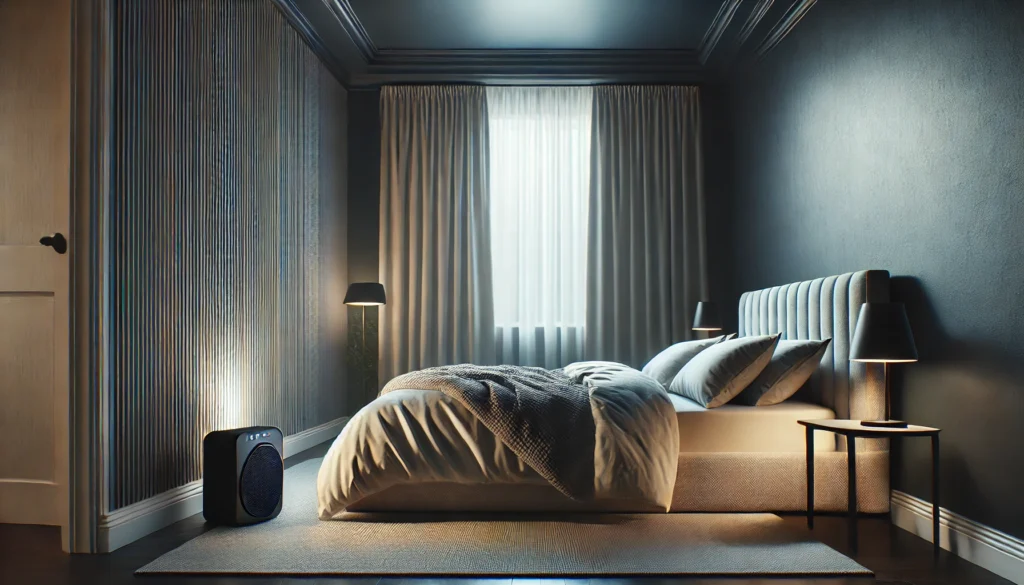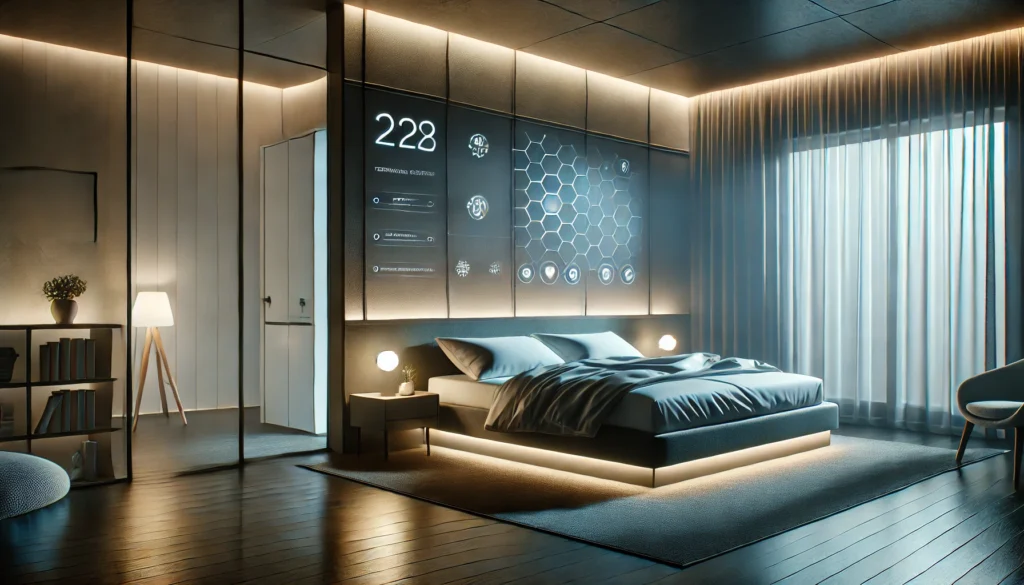Before embarking on the journey of creating an ideal sleep setting, it’s crucial to comprehend the science underpinning sleep itself. Sleep is a complex biological process governed by the circadian rhythm, a natural internal clock that regulates the sleep-wake cycle. This rhythm is influenced by external factors such as light, temperature, and lifestyle habits.
The Role of Circadian Rhythm
The circadian rhythm is a 24-hour cycle in the physiological processes of living beings, including humans. It is influenced by external cues like sunlight and temperature. Disruption in this rhythm can lead to sleep disorders and other health issues. Understanding your personal circadian rhythm can help tailor your sleep environment to better support your natural sleep-wake cycle.
Sleep Stages and Their Importance
Sleep is divided into several stages, including REM and non-REM sleep, each playing a vital role in health. Non-REM sleep is crucial for physical restoration, while REM sleep supports cognitive functions such as memory and learning. A balanced sleep environment helps you transition through these stages smoothly, ensuring restorative rest.
External Influences on Sleep
External factors such as stress, diet, and exercise can significantly impact sleep quality. The interplay between these factors and your sleep environment is essential for achieving restful sleep. By managing external stressors and aligning your environment with your sleep needs, you can enhance sleep quality and overall well-being.
You May Also Like: Benefits of Consistent Sleep Schedules Explained
The Thermal Comfort Zone: What Temperature is Best?
Determining the optimal sleep temperature is a nuanced endeavor, as comfort can be subjective. However, research indicates that the ideal bedroom temperature for sleep generally falls between 60 and 67 degrees Fahrenheit (15.5 to 19.5 degrees Celsius). This range supports the body’s thermal regulation mechanisms, allowing for uninterrupted sleep cycles.
How Hot is Too Hot to Sleep?
Sleeping in a hot room can be detrimental to sleep quality, causing increased wakefulness and reduced REM sleep. When the room temperature exceeds 75 degrees Fahrenheit (24 degrees Celsius), the body struggles to dissipate heat, leading to discomfort and disturbed sleep. Prolonged exposure to high temperatures at night can also affect hormone regulation and metabolism.
Best Temperature for Sleeping in Summer
During summer months, maintaining a cool sleeping environment can be challenging. Utilizing fans, air conditioning, or breathable bedding materials can help keep the bedroom within the recommended temperature range. It is also beneficial to close curtains or blinds during the day to prevent heat buildup. Additionally, exploring nighttime cooling strategies such as cold showers or cooling pads can offer relief during hot nights.
Adapting to Seasonal Changes
As seasons change, so do temperature preferences for sleep. During colder months, some may prefer a warmer room, though it should still be within the optimal range. Using layered bedding allows for flexibility, enabling adjustments without compromising comfort. Consider integrating smart thermostats that adjust the room temperature based on external weather conditions and personal preferences.

The Effects of Sleeping in a Hot Room
The consequences of sleeping in a hot room extend beyond mere discomfort. Elevated room temperatures can lead to increased perspiration, dehydration, and heightened stress levels, all of which can negatively impact sleep quality. Chronic exposure to excessive heat during sleep may also contribute to metabolic disturbances and cardiovascular stress.
Sweating and Dehydration
High temperatures can cause excessive sweating, leading to dehydration if fluids are not replenished. Dehydration affects overall health and can exacerbate sleep disturbances. Ensuring adequate hydration throughout the day and before bed can mitigate these effects, but care should be taken to avoid excessive fluid intake immediately before sleep.
Stress and Mood Implications
Heat-induced discomfort can elevate stress levels, affecting mood and emotional well-being. This stress can disrupt sleep cycles, creating a feedback loop that further impacts mental health. Incorporating relaxation techniques such as meditation or deep breathing exercises before bed can help alleviate stress and promote better sleep.
Long-term Health Risks
Consistently sleeping in a hot environment may increase the risk of developing long-term health issues. Over time, it can contribute to cardiovascular problems, weight gain, and decreased immune function. By prioritizing a comfortable sleep temperature, you not only improve immediate sleep quality but also safeguard your long-term health.
Crafting a Sleep-Inducing Environment
Creating a sleep-friendly environment involves more than just regulating temperature. Consider the following elements to enhance your sleep space:
Light
Exposure to light significantly influences the circadian rhythm. To promote sleep, minimize exposure to artificial light sources in the evening and opt for blackout curtains to block external light pollution. Consider using dim, warm-toned lighting in the bedroom to signal to your body that it’s time to wind down. Limiting screen time before bed and using night mode features on devices can further reduce blue light exposure.
Sound
Ambient noise can be both beneficial and disruptive, depending on its nature and timing. White noise machines or apps can help mask disruptive sounds, promoting a more consistent and restful sleep. In contrast, sudden noises can cause sleep disturbances, so consider soundproofing your room or using earplugs. Natural soundscapes, like ocean waves or rain, can also create a calming backdrop conducive to sleep.
Bedding and Mattress
Investing in high-quality bedding and a supportive mattress is paramount. Choose materials that enhance comfort and breathability, such as cotton or linen, and consider the firmness and support level that suits your sleeping style. Regularly replacing pillows and maintaining a clean sleep space can prevent allergens and ensure comfort. Tailor your bedding choices to seasonal needs, opting for lighter fabrics in summer and warmer options in winter.
Personalizing Your Space
Your bedroom should reflect personal comfort preferences and aesthetics. Adding personal touches such as soothing colors, favorite scents, or meaningful decor can enhance relaxation. Aromatherapy, through essential oils like lavender or chamomile, can also promote a calming atmosphere. Regularly decluttering the space can reduce distractions and create a serene environment.

Historical Context and Future Implications
Throughout history, humans have adapted their sleeping environments to align with cultural and technological advancements. From the communal sleeping arrangements of ancient civilizations to the individualized sleep solutions of today, the pursuit of restful sleep has been a constant human endeavor.
Evolution of Sleep Spaces
In ancient times, communal sleeping was common, often dictated by safety and warmth needs. As societies evolved, private sleeping quarters became more common, reflecting shifts in cultural norms and lifestyle changes. Understanding this evolution can provide insights into the psychological and social factors that influence our sleep environments today.
Technological Innovations
The integration of technology in sleep environments promises to revolutionize how we approach rest. Innovations such as temperature-regulating mattresses, smart thermostats, and sleep-tracking devices offer personalized solutions that cater to individual sleep preferences. These technologies not only enhance comfort but also provide data-driven insights to improve sleep hygiene.
The Future of Sleep Environments
Looking forward, advancements in sleep technology and research will continue to shape how we design our sleep spaces. Emerging trends, such as AI-driven sleep optimization and sustainable bedding materials, highlight the growing focus on health and environmental consciousness. Staying informed about these developments can empower you to make informed decisions that align with future sleep needs.
Practical Advice for Implementing Changes
Implementing changes to your sleep environment can be a gradual process. Start by assessing your current setup and identifying areas for improvement. Consider the following steps:
Evaluate Room Temperature
Use a thermometer to monitor your bedroom temperature and make adjustments as needed. Experiment with different cooling methods to find what works best for you. Consider using programmable thermostats for automatic adjustments, ensuring a consistent sleep-friendly temperature throughout the night.
Upgrade Bedding
Assess the comfort and breathability of your bedding. Consider investing in moisture-wicking sheets or a cooling mattress topper. Regularly evaluate the condition of your mattress and pillows, replacing them when necessary to maintain optimal support and hygiene.
Optimize Lighting
Install blackout curtains and reduce screen time before bed. Use blue-light-blocking glasses if necessary. Experiment with smart lighting systems that adjust brightness and color temperature to align with your circadian rhythm, creating a conducive environment for sleep onset.
Minimize Noise
Identify sources of disruptive noise and explore solutions such as soundproofing or white noise machines. Test different soundscapes to find what best masks disturbances and promotes relaxation. Consider repositioning your bed or using heavy curtains to dampen external noise.
Integrate Technology
Explore smart home devices that can enhance your sleep environment, such as smart thermostats or sleep trackers. These devices can provide insights into sleep patterns and suggest personalized adjustments to improve sleep quality. Stay updated on emerging technologies and incorporate them as they align with your sleep goals.

Conclusion
Creating the perfect sleep environment is a personalized journey that requires attention to detail and a willingness to experiment. By understanding the scientific principles of sleep and implementing practical changes, you can cultivate an environment that supports restful, rejuvenating sleep. As research continues to advance, staying informed about new trends and technologies will empower you to make informed decisions that enhance your sleep quality and overall well-being. Embrace this journey with an open mind, and enjoy the profound benefits of truly restorative sleep.
Further Reading:
How to Beat the Heat for a Restful Sleep
Why Do I Get So Hot When I Sleep?
Important Note: The information contained in this article is for general informational purposes only, and should not be construed as health or medical advice, nor is it intended to diagnose, prevent, treat, or cure any disease or health condition. Before embarking on any diet, fitness regimen, or program of nutritional supplementation, it is advisable to consult your healthcare professional in order to determine its safety and probable efficacy in terms of your individual state of health.
Regarding Nutritional Supplements Or Other Non-Prescription Health Products: If any nutritional supplements or other non-prescription health products are mentioned in the foregoing article, any claims or statements made about them have not been evaluated by the U.S. Food and Drug Administration, and such nutritional supplements or other health products are not intended to diagnose, treat, cure, or prevent any disease.


